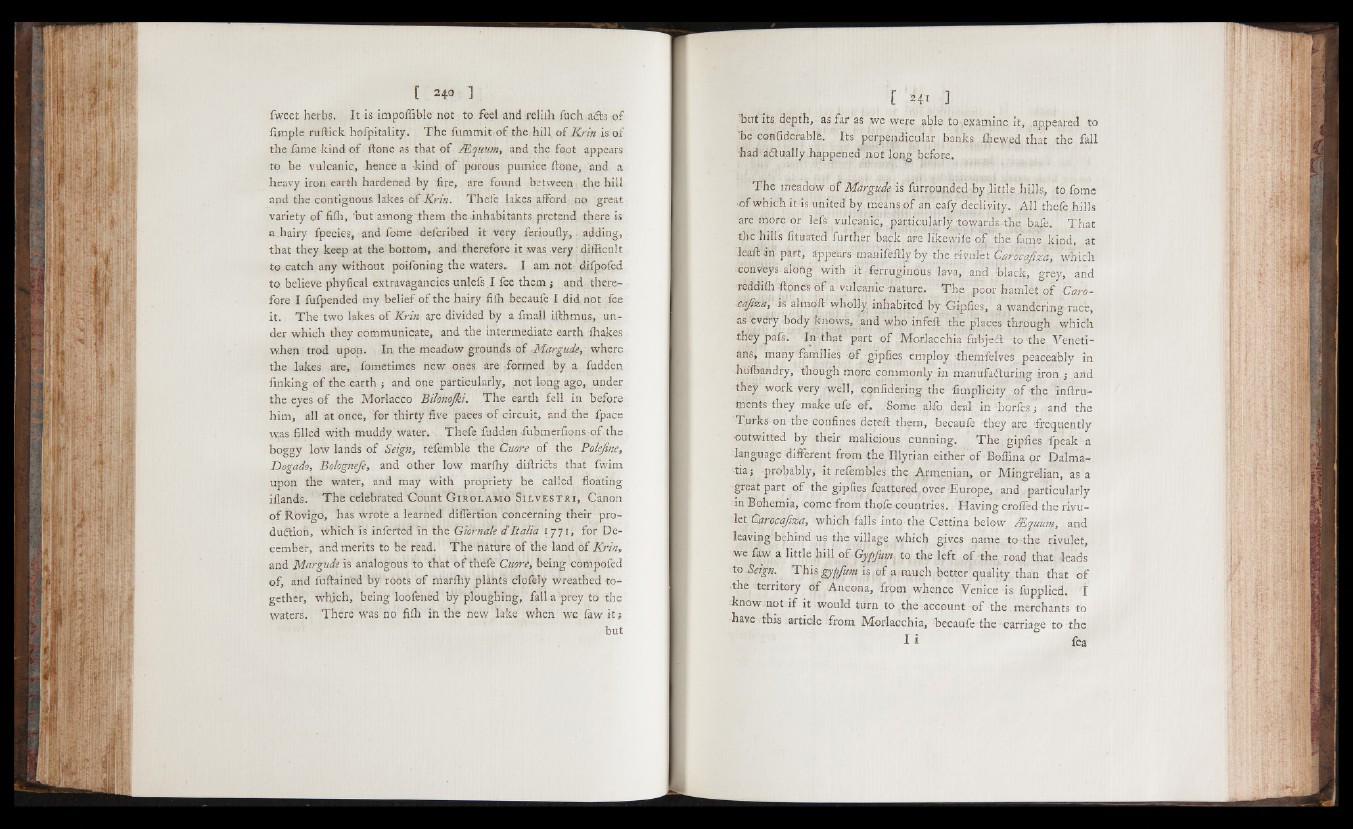
fweet herbs. It is impoffible not to feel and reliffi fuch a'dbs of
Ample ruftick hofpitality. The fummit o f the hill of Krin is of
the fame kind o f ftone as that o f Milium, and the foot appears
to be vulcanic, hence a -kind o f porous pumice ftone, and a
heavy iron earth hardened by fire, are found between the hill
and the contiguous lakes o f Krin. Thefe lakes afford no great
variety o f fifli, 'but among them the inhabitants pretend there is
a hairy fpecies, and fome defcribed it very ferioufly,. adding,
that they keep at the bottom, and therefore it -was very difficult
to catch any without poifoning the waters. I am not difpofed
to believe phyfical extravagancies unlefs I fee them ; and therefore
I fufpended my belief o f the hairy fifh becaufe I did not fee
it. The two lakes of Krin are divided by a fmall ifthmus, under
which they communicate, and the intermediate earth ffiakes
when trod upon. In the meadow grounds o f -Margude, where
the lakes are, fometimes new ones are formed by a fudden
finking o f the earth ; and one particularly, not long agp, under
the eyes o f the Morlacco Bilonojki. The earth fell in before
him, all at once, for thirty five paces o f circuit, and the fpace
ryas .filled with muddy water. Thefe hidden fubmerfions -of the
boggy low lands o f Seign, refemble the Cuore of the Polejine»
Dogado, Bolognefe, and other low marfhy diftricts that fwim
upon the water, and may with propriety be called floating
iflands. The celebrated'Count G irolamo Si l v e s t r i , Canon
o f Rovigo, has wrote a learned differt-ion concerning their pro-
ductioh, which is infertedln the Giornale d'Italia 1771, for December,
and merits to be read. The nature of the land o f Krin,
and Margude is analogous to that o f thefe Cuore, being compofed
of, and fuftained by roots o f niariliy plants dofely wreathed together,
which, being loofened by ploughing, fall a prey to the
waters. There was no fifh in the new lake' when we faw it ;
but
but its. depth, as far as we were able to .examine it, .appeared to
"be coftfiderable. .Its'peipen.diculaf.. banks, fhe^ved that the fall
had actually happened .not long before.
The meadow o f Margude is furrounded by Tittle .hills, to fome
•of which it is united by trieansof an eafy declivity. .All thefe hills
are more or lefs vulcapiA'particularlytowards the ba|e. That
the hills fituated further ’bacjc'" are l^ev^iie'o^'the^m'e kind, at
leaft in part, appears-nianifeftly by the rivulet Garcca/iza, which
conveys along with ,it ferruginous lava, and fla c k , grey, and
reddiih -Hones o f a vulcanic -nature. The poor hamlet o f Caro-
cajiza, us alinoft wholly inhabited by Oipfies, a wandering race,
as evdry body knows,- and who infeft the places through which
iheypafs." In that” part o f Morlacchia ftibj-eft -to the Venetians;
many families o f -gipfies -employ them-felves peaceably in
■hufbandry, though more commonly in manufaifturing iron ; arid
they work very well, cQnfidering the frmplicit-y o f the inftru-
ments they make-ufe of, -Some alio deal in-horfes; , and the
Turks on the confines deleft them, becaufe -they are frequently
outwitted by their malicious cunning. The gipfies fpeak a
language different from the Illyrian either o f Boffina or Dalmatia;
probably, it refembles.the .Armenian, or Mingreliari, as a
great part o f the gipfies fcattered over Europe, and particularly
in Bohemia, come-from thofe-countries. Ilcving croficd the rivulet
Caro ca/iza, which falls into the Cettina below JRquiitn, and
leaving behind us the village which gives name to-the rivulet,
we faw a little hill o f Gypfutn to the left of-the road that leads
to Seign. This gypfum is o f a much better quality than that o f
the territory o f Ancona, from whence Venice is fupplied. I
know.not i f it would turn to the account o f the merchants to
have this article from Morlacchia, becaufe the carriage to the
1 1 fea